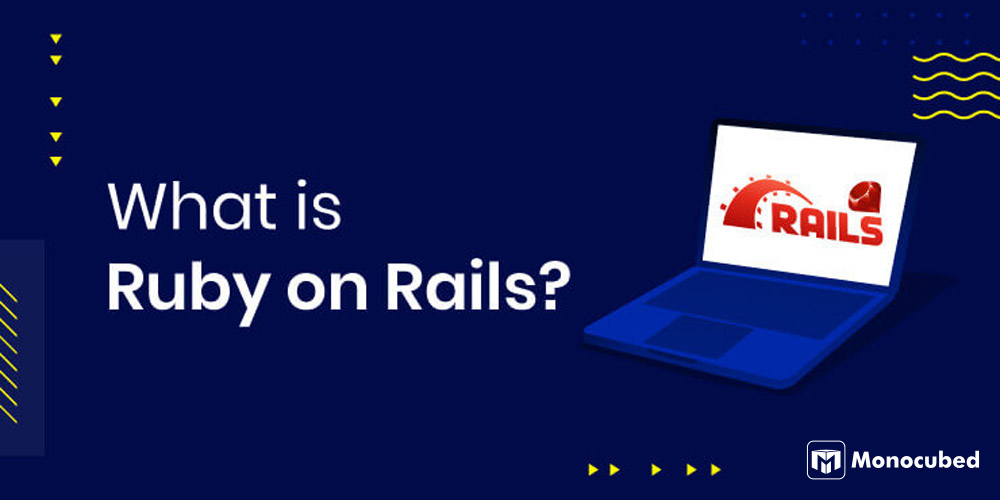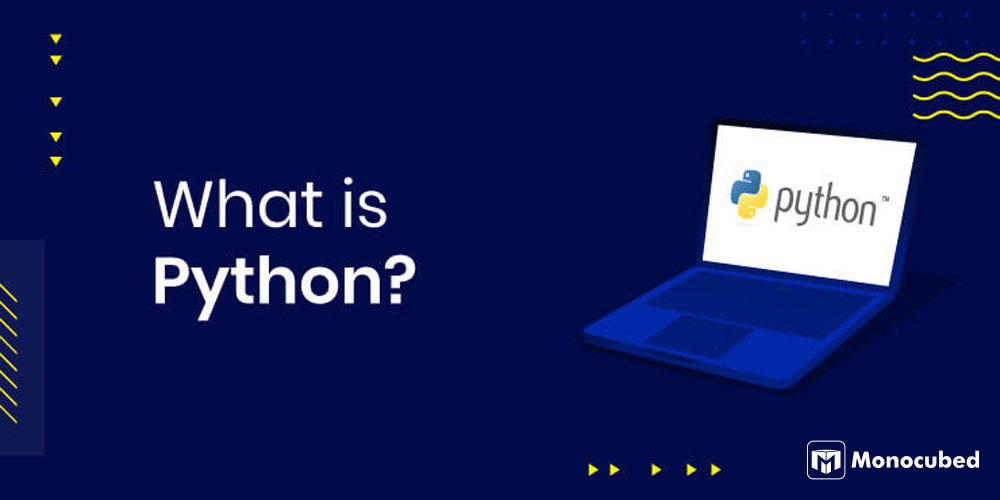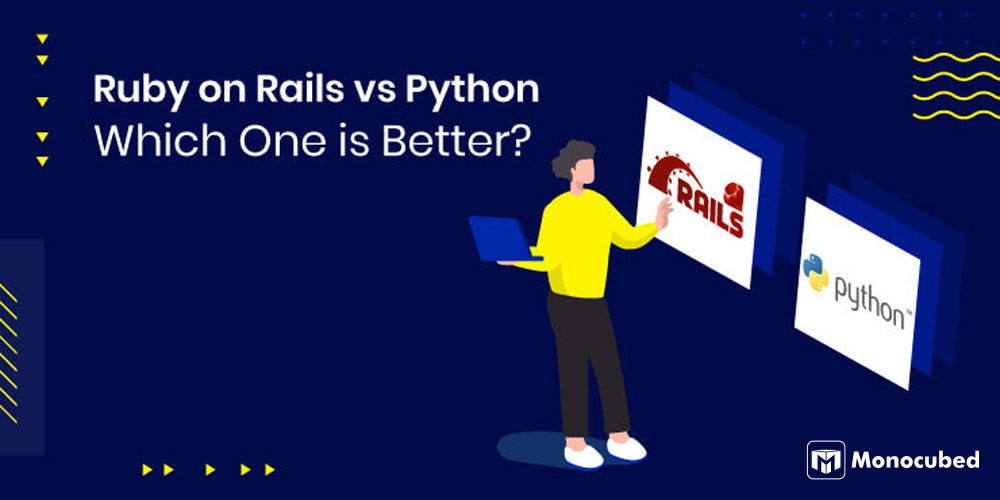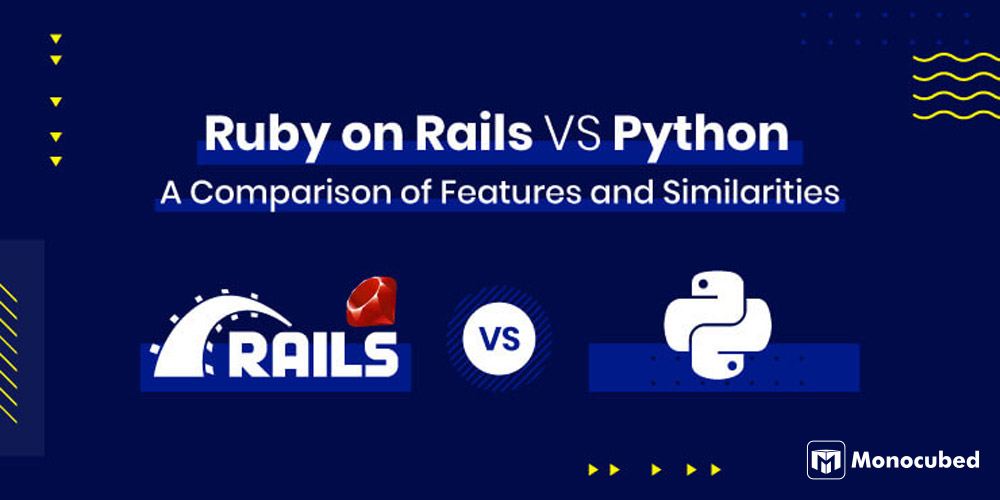For a few years, the programming planet has evolved exceptionally.As we observe the mounting demand for getting everything digital, it has been imperative for us to understand which programming language is best suited for different kinds of needs.
While planning about your web development project, you would look for a framework that could render every tool you require. This brings us to the most baffling question Ruby on Rails VS Python – which web framework should we opt for?
There are various similarities and dissimilarities between Ruby and Python programming languages. These two languages are some of the best instances of high-level languages which tend to focus on simplicity and facilitating the programmer to get things done faster, instead of juggling around rigid hierarchy and syntax correctness.
Both Rails and Python can be utilized to develop sites and applications with any functionality and complexity. To understand the analytical difference these languages possess, let us examine its vital concepts.
Table of Content
Ruby on Rails

Ruby on Rails (RoR) is a server-side model-view-controller (MVC) framework that provides default patterns for web service, web pages, and databases. It was invented by David Heinemeier Hansson in 2004 and leveraged web application development through its distinctive traits like the scaffolding of views, flawless database table formations, and migrations.
It is meant to uplift the application of web standards like XML or JSON for data transmission and JavaScript, CSS, and HTML for the user interface.
Ruby is a server-side and potent language that yields readable and elegant code while preserving its articulacy. To understand what Ruby on Rails is, you must be familiar with the MVC architecture. Along with this pattern, Rails accentuates employing other renowned software engineering paradigms which include the active record pattern, don’t repeat yourself (DRY), and convention over configuration (CoC).
Its robust framework has lots of built-in functions and libraries, making you focus on definite business requirements. Some of the giant companies that use rails are Shopify, Github, Hulu, Airbnb, to name a few.
Features
Many programming languages like HTML, JavaScript, SQL, and CSS do not support front-end and back-end both. But Ruby on Rails programming comprises both ends that help developers to create web applications. In the strife between Ruby on Rails vs Javascript, the main consideration is that Java is a compiled coding language, whereas Ruby is an interpreted scripting language.
As a Ruby on Rails consulting company, we recommend Rails web framework because of these key features it offers –
-
Testing
Ruby on Rails web development has a unit testing set-up named RSpec and it is much easy to understand. As it is basic Ruby, you can utilize it to test functions exercised in the app by calling them separately. It aids you to guarantee that your web applications have been tested appropriately.
-
MVC Pattern
Ruby on Rails framework has an MVC architecture that is an extensively used web app pattern in web development. So, it becomes easy for web developers who are familiar with other frameworks working on MVC patterns.Rails architecture splits the codes of diverse functions, namely, data layer, presentation layer, and conserving a resource layer.
-
Active Record
Rails has a robust library named the active record, making it easier for developers to devise data base interaction query. This is for the reason that they write the query in Ruby language, which is subsequently converted into a SQL query.
-
Automatic Deployment
Rails comprise libraries that allow the code to process with reduced time and fewer efforts. With a one-time set up at an initial stage and a single line on command interface, it deploys each change you have performed to the procedure.
Want to Develop a Scalable, Cost-efficient Web App?
Convert your web app idea into a low-cost, high-performance, scalable web app with our RoR developers. Let’s validate your idea and start developing.
Python

Python is a high-level, all-purpose programming language. It was invented by Guido van Rossum in 1991. Python’s philosophy lays importance on readability with its prominent utilization of vital whitespace. It follows an object-oriented approach that aids programmers to write logical and clear code for big as well as small-scale projects.
The famous websites built using Python are Dropbox, Spotify, Lyft, Instacart, to name a few.
Python is one of the mounting programming languages, owing to its wide array of usage from machine learning to data science, and also in academics. We provide Python software development services that include AI-ML solutions, custom enterprise solutions, cross-platform apps and more.
It is vigorously typed and garbage-collected. Many programming prototypes, including functional and structured are supported by Python. It is usually portrayed as a ‘batteries included’ language as it has an all-inclusive library.
Features
Python is an advanced language that facilitates the creation of both, simple and complex functionalities. Also, it comes with an in-built wide range of modules and libraries, aiding to support various languages – C, C++, JSON, and Java. The below-mentioned key features would suffice your question – what is Python used for and reasons to consider it for your business.
-
Simple
In Python vs Ruby on Rails, Python is easy to learn. Its syntax is uncomplicated and similar to English language. There is no requirement of curly bracket or semicolon, the imprint states the code block. For beginners, it is the most recommended language to learn and practice.
-
Interpreted & Integrated Language
It is an interpreted language as Python code is performed line by line, one at a time. There is no requirement for compiling the code, which makes it effortless to debug code. Its source code is then converted into an instant form, termed as bytecode.
It is also an integrated language as you can simply integrate it with other languages namely JAVA, C, C++, and related.
-
GUI Programming
Graphical User Interface is employed for the development of desktop applications.Tkinter, PyQT5, Kivy are some of the Python libraries that are used for such a development and PyQt5 is the most admired option.
-
Open-source
Python is an open-source language, which means that the source code is easily accessible to the community. It is also freely available for download at its website.
-
Extensible & Portable
It is a portable language. You can write some Python code in C or C++, and also, you can assemble those codes in C or C++ language.
If you have Python code for Windows but if you want to function these codes on another platform like Unix, Linux, and Mac, then you do not have to alter it. You can employ Python code on any kind of platform.
Similarities in Rails and Python
Python and Ruby on Rails are both are powerful server-side technologies that aid in robust development of web prototypes and applications. These two popular technologies, though different, have some similarities listed below:
- Both Python and Rails are cross-platform, making it convenient for the teams where they might use Linux or Windows.
- Python and Ruby are advanced scripting languages, which means their programs are not ought to be assembled.
- They support object-oriented programming (OOP).
- Rails and Python can be used for building web applications that are scalable, portable and database-driven.
- A GNU Debugger (GDB) technique is presented in each language.
- Both are obtainable through Lambda functions at Amazon Web Services.
- Ruby, Python are both vigorously typed, which states that you can employ a variable without presenting it first.
- They possess clean syntax and are effortlessly readable.
Ruby on Rails vs Python: Main Differences
In the discord between Ruby vs Python, both languages promising for start-ups and established enterprises. Though they look similar, the difference between Ruby and Python can be observed in their approaches to solving complexities. The major differences to observe before considering Ruby or Python are as follows:
| Factors | Ruby on Rails | Python |
|---|---|---|
| Core fields | It is mainly into functional programming and web development. | It has its chief presence in scientific and academic programming. It also possesses a vast library for data science. |
| Properties | An expressive, elegant, and efficient language. | An easy to learn, speedy, efficient, code readability language. |
| Usage Case | It can implement complex and high-traffic applications and sites rapidly. | It can operate faster with big data, scientific calculations, and math. Hence, it is preferred by data scientists for data analysis. |
| Principle | ‘Attain more with less.’ Flexibility and freedom to function in countless ways. | ‘One apt way to attain things.’ It functions on simplicity over flexibility. |
| Coding and Updates | It has a creative style of coding, regular updates, and readable codes. | It is very stable. It has a conservative style of coding and lesser updates. |
| Functionality | Ruby does not have various functions. It has ways that have to be encased in procs to pass them. | Python has numerous functions. |
| Mixins | Mixins can be utilized, as it supports various inheritances. | Mixins cannot be utilized, as it does not support various inheritances. |
| Built-in Classes | It is not feasible to amend built-in classes. | Built-in classes can be amended. |
| Switch-case Statements | It supports switch-case statements. | It does not support switch-case statements. |
| Primitive Data Type | Rails have no primitive data types. Everything here is an object. | Python has both primitive data-types and objects. |
| Flexibility | Rails are more flexible as there are more than one way of performing any task. | There is only one apparent way to perform a task. Hence, it is less flexible. |
Want to Develop an Advanced Web App?
Chatbots? Handwriting to text? Auto text completion? Integrate such advanced features into your web app with the help of our Python developers.
Ruby on Rails or Python?
Whether you select Python or Ruby on Rails, both are exceptional programming languages for web development with proficient procedures and a vast community. Python must be preferred where big data is included. While Ruby on Rails works great with high-traffic applications.

Selecting one technology over another seems a tough call, as both are proven popular web frameworks.
The framework used for Ruby is Ruby on Rails, whereas Python supplies a library of interfaces with POSIX or UNIX variants but opts to select or poll, as per the situation. The most popular Python framework is Django. While it is tough to compare Python language with Rails framework, we have analyzed the usage of Django and Rails.
Frequently Asked Questions
Is Python stable?
Python is very stable. With the regular and stable releases, and it seems to be continuously evolving. As stated in this blog, whether to opt for Ruby on Rails or Python, it’s clear that Python must be chosen if we have big data. The developers’ concerns ‘bugfix’ releases of previous versions, so the steadiness of the current releases gradually enhances. Bugfix releases, specified by a third component of the version, are administered for stability.
Is Ruby on Rails dying?
Ruby on Rails has been constantly evolving and becoming more a mature framework, thereby forming its niche. Big giants like Github, Airbnb, Zendesk, Shopify, and more are utilizing it for its robust characteristics. Most of the RoR developers use it as one of the tools of their stack and play to its strengths, rather than employing it to be the main tool for building apps. Due to Rail’s pace of development and simple business logic execution, it is still widely used.
How is memory managed in Python?
The management of memory in Python is managed by ‘Python private heap space’. All Python data structures and objects are situated in a private heap. The web developer does not have the right to access this private heap. Instead, the python interpreter takes care of this. Python has an in-built garbage collector, which does the recycling of all unused memory so that it can be made obtainable to heap space.
Conclusion
For robust web development, Python has Django and Ruby has Rails. Ruby and Python, both languages provide a powerful framework with a large community. Usually, you can opt for Python when you have to perform data computing and processing. And if you desire to havehigh traffic applications, you can choose Ruby on Rails.
In Python vs Ruby on Rails, we have observed some analytical dissimilarities to get a clear understanding before selecting an apt web framework. If you are still in the dilemma of choosing an apt tech stack, contact us for availing of the best framework suitable for your web development.
As we have seen, both Python and Ruby are advanced and object-oriented languages that are written for definite purposes. Selecting one language for your web development completely depends on your business requirements and personal choice.
 By Jeel Patel
By Jeel Patel



